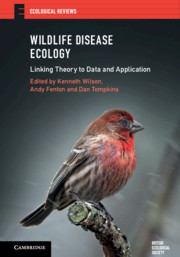Book contents
- Wildlife Disease Ecology
- Ecological Reviews
- Wildlife Disease Ecology
- Copyright page
- Contents
- Contributors
- Preface: Wildlife Disease Ecology
- Glossary of Terms
- Part I Understanding within-host processes
- Chapter one Pollinator diseases: the Bombus–Crithidia system
- Chapter Two Genetic diversity and disease spread: epidemiological models and empirical studies of a snail–trematode system
- Chapter Three Wild rodents as a natural model to study within-host parasite interactions
- Chapter Four From population to individual host scale and back again: testing theories of infection and defence in the Soay sheep of St Kilda
- Chapter Five The causes and consequences of parasite interactions: African buffalo as a case study
- Chapter Six Effects of host lifespan on the evolution of age-specific resistance: a case study of anther-smut disease on wild carnations
- Chapter Seven Sexually transmitted infections in natural populations: what have we learnt from beetles and beyond?
- Part II Understanding between-host processes
- Part III Understanding wildlife disease ecology at the community and landscape level
- Index
- Plate Section (PDF Only)
- References
Chapter Seven - Sexually transmitted infections in natural populations: what have we learnt from beetles and beyond?
from Part I - Understanding within-host processes
Published online by Cambridge University Press: 28 October 2019
- Wildlife Disease Ecology
- Ecological Reviews
- Wildlife Disease Ecology
- Copyright page
- Contents
- Contributors
- Preface: Wildlife Disease Ecology
- Glossary of Terms
- Part I Understanding within-host processes
- Chapter one Pollinator diseases: the Bombus–Crithidia system
- Chapter Two Genetic diversity and disease spread: epidemiological models and empirical studies of a snail–trematode system
- Chapter Three Wild rodents as a natural model to study within-host parasite interactions
- Chapter Four From population to individual host scale and back again: testing theories of infection and defence in the Soay sheep of St Kilda
- Chapter Five The causes and consequences of parasite interactions: African buffalo as a case study
- Chapter Six Effects of host lifespan on the evolution of age-specific resistance: a case study of anther-smut disease on wild carnations
- Chapter Seven Sexually transmitted infections in natural populations: what have we learnt from beetles and beyond?
- Part II Understanding between-host processes
- Part III Understanding wildlife disease ecology at the community and landscape level
- Index
- Plate Section (PDF Only)
- References
Summary
Sexually transmitted infections (STIs) can be found in a range of hosts. Their epidemiology is predicted to vary with mean and variance in number of mating partners and, in more refined models, contact and social structure. Weak dependence of mating rate on host density leads to a prediction of density-independent dynamics, including the possibility that sterilising infections could drive their hosts extinct. Infection’s impact on the host is predicted to select for mate choice against infected partners and reduced mating rates. We examine these predictions against STIs in nature, with a particular focus on studies of beetle–ectoparasitic mite interactions. The Adalia bipunctata–Coccipolipus interaction has given rich insights, with ease of scoring infection and mating activity in natural populations enabling detailed documentation of dynamics. Laboratory study has allowed precise estimation of transmission parameters to inform models and focused analysis of behaviour. These studies have confirmed the core impact of mating rate on STI dynamics, but revealed unexpected drivers such as food supply (positively driving mating rate) and sex ratio (enhancing spread and producing male-biased prevalence), alongside constraints on spread from host phenology.
Keywords
- Type
- Chapter
- Information
- Wildlife Disease EcologyLinking Theory to Data and Application, pp. 187 - 222Publisher: Cambridge University PressPrint publication year: 2019
References
- 2
- Cited by

